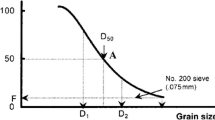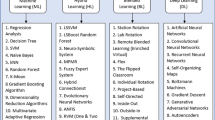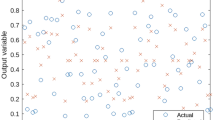Abstract
Estimating soil compaction parameters is an essential point when seeking safe and economic dams, bridges abutments, highways embankments, retaining walls, and nuclear waste disposal; however, the Proctor Test employed in this forecasting is costly and time-consuming. The current study, therefore, aims at elaborating a new alternative model for predicting the compaction parameters based on eleven new progressive machine learning methods to overcome these limitations. The modeling phase was performed using a database of 147 samples collected from different studies. Additionally, six relevant factors were selected in the input layer based on the literature recommendations. Furthermore, the relevant inputs have been modeled using machine learning methods; their performance was assessed through six performance measures and the K-fold cross-validation approach. The comparative study proved the effectiveness of the RF model, which displayed the highest performance in predicting soil compaction parameters. This elaborated model provided the optimal prediction, i.e., the closest to the experimental values compared to other models and formulae proposed in the literature. Finally, a reliable and easy-to-use graphical interface was generated in the current study dubbed “ComPara2021.” This latter will be very helpful for researchers and civil engineers when estimating compaction parameters with the advantage of saving time and money.





Similar content being viewed by others
References
Ahangar-Asr, A., Faramarzi, A., Mottaghifard, N., Javadi, A.A.: Modeling of permeability and compaction characteristics of soils using evolutionary polynomial regression. Comput. Geosci. 37, 1860–1869 (2011). https://doi.org/10.1016/j.cageo.2011.04.015
Alavi, A.H., Gandomi, A.H., Mollahasani, A., Bazaz, J.B.: Linear and tree-based genetic programming for solving geotechnical engineering problems. In: Yang, X. S., Gandomi, A. H., Talatahari, S., Alavi, A. H. (Eds.) Metaheuristics in Water, Geotechnical and Transport Engineering, pp. 289–310. Elsevier, Netherlands (2013).
Al-Khafaji, A.N.: Estimation of soil compaction parameters by means of Atterberg limits. Q. J. Eng. Geol. Hydrogeol. 26, 359–368 (1993). https://doi.org/10.1144/GSL.QJEGH.1993.026.004.10
Ardakani, A., Kordnaeij, A.: Soil compaction parameters prediction using GMDH-type neural network and genetic algorithm. Eur. J. Environ. Civ. Eng. 23, 449–462 (2019). https://doi.org/10.1080/19648189.2017.1304269
Benbouras, M.A., Petrişor, A.-I., Zedira, H., Ghelani, L., Lefilef, L.: Forecasting the Bearing Capacity of the Driven Piles Using Advanced Machine-Learning Techniques. Appl. Sci. 11, 10908 (2021). https://doi.org/10.3390/app112210908
Benbouras, M.A.: Predicting shear stress parameters in consolidated drained conditions using artificial intelligence methods. BAS-SJKFU. 22, 1–7 (2021). https://doi.org/10.37575/b/sci/0069
Benbouras, M.A., Petrisor, A.-I.: Prediction of Swelling Index Using Advanced Machine Learning Techniques for Cohesive Soils. Appl. Sci. 11, 536 (2021). https://doi.org/10.3390/app11020536
Benbouras, M.A., Kettab, R.M., Zedira, H., Petrisor, A.-I., Debiche, F.: Dry density in relation to other geotechnical proprieties of Algiers clay. Rev. Şcolii Dr. Urban. 2, 5–14 (2017)
Benbouras, M.A., Kettab, R., Zedira, H., Petrisor, A., Mezouer, N., Debiche, F.: A new approach to predict the compression index using artificial intelligence methods. Mar. Georesour. Geotechnol. 37, 704–720 (2018a). https://doi.org/10.1080/1064119X.2018.1484533
Benbouras, M.A., Kettab, R.M., Zedira, H., Debiche, F., Zaidi, N.: Comparing nonlinear regression analysis and artificial neural networks to predict geotechnical parameters from standard penetration test. Urban., Archit., Constr. 9, 275–288 (2018b)
Biau, G., Scornet, E.: A random forest guided tour. Test 25, 197–227 (2016). https://doi.org/10.1007/s11749-016-0481-7
Blotz, L.R., Benson, C.H., Boutwell, G.P.: Estimating optimum water content and maximum dry unit weight for compacted clays. J. Geotech. Geoenviron. Eng. 124, 907–912 (1998). https://doi.org/10.1061/(ASCE)1090-0241(1998)124:9(907)
Breiman, L., Spector, P.: Submodel selection and evaluation in regression. The X-Random Case. Int Stat Rev 60, 291–319 (1992). https://doi.org/10.2307/1403680
Cai, G., Liu, S., Puppala, A.J.: Evaluation of pile bearing capacity from piezocone penetration test data in soft jiangsu quaternary clay deposits. Mar. Georesour. Geotechnol. 29, 177–201 (2011). https://doi.org/10.1080/1064119X.2011.556887
Chen, R.-P., Wang, H.-L., Hong, P.-Y., Cui, Y.-J., Qi, S., Cheng, W.: Effects of degree of compaction and fines content of the subgrade bottom layer on moisture migration in the substructure of high-speed railways. Proc. Inst. Mech. Eng. F J. Rail Rapid Transit. 232, 1197–1210 (2018). https://doi.org/10.1177/0954409717710838
Chen, R.-P., Qi, S., Wang, H.-L., Cui, Y.-J.: Microstructure and hydraulic properties of coarse-grained subgrade soil used in high-speed railway at various compaction degrees. J. Mater. Civ. Eng. 31, 04019301 (2019). https://doi.org/10.1061/(ASCE)MT.1943-5533.0002972
Ciaburro, G.: MATLAB for Machine Learning. Packt Publishing Ltd, Birmingham (2017).
Debiche, F., Kettab, R.M., Benbouras, M.A., Benbellil, B., Djerbal, L., Petrisor, A.-I.: Use of GIS systems to analyze soil compressibility, swelling and bearing capacity under superficial foundations inalgiers region, algeria. Urban., Archit., Constr. 9, 357–370 (2018)
Delage, P., Marcial, D., Cui, Y.J., Ruiz, X.: Ageing effects in a compacted bentonite: a microstructure approach. Géotechnique 56, 291–304 (2006). https://doi.org/10.1680/geot.2006.56.5.291
Di Sante, M.: On the compaction characteristics of soil-lime mixtures. Geotech Geol. Eng. 38, 2335–2344 (2020). https://doi.org/10.1007/s10706-019-01110-w
Di Matteo, L., Bigotti, F., Ricco, R.: Best-fit models to estimate modified proctor properties of compacted soil. J. Geotech. Geoenviron. Eng. 135, 992–996 (2009). https://doi.org/10.1061/(ASCE)GT.1943-5606.0000022
Douak, F., Melgani, F., Benoudjit, N.: Kernel ridge regression with active learning for wind speed prediction. Appl. Energy 103, 328–340 (2013). https://doi.org/10.1016/j.apenergy.2012.09.055
Farooq, K., Khalid, U., Mujtaba, H.: Prediction of compaction characteristics of fine-grained soils using consistency limits. Arab J. Sci. Eng. 41, 1319–1328 (2016). https://doi.org/10.1007/s13369-015-1918-0
Goetz, J.N., Brenning, A., Petschko, H., Leopold, P.: Evaluating machine learning and statistical prediction techniques for landslide susceptibility modeling. Comput. Geosci. 81, 1–11 (2015). https://doi.org/10.1016/j.cageo.2015.04.007
Günaydın, O.: Estimation of soil compaction parameters by using statistical analyses and artificial neural networks. Environ. Geol. 57, 203 (2008). https://doi.org/10.1007/s00254-008-1300-6
Gurtug, Y., Sridharan, A.: Compaction behaviour and prediction of its characteristics of fine grained soils with particular reference to compaction energy. Soils Found. 44, 27–36 (2004). https://doi.org/10.3208/sandf.44.5_27
Gurtug, Y., Sridharan, A., İkizler, S.B.: Simplified method to predict compaction curves and characteristics of soils. Iran J. Sci. Technol. Trans. Civ. Eng. 42, 207–216 (2018). https://doi.org/10.1007/s40996-018-0098-z
Hebiri, M., Lederer, J.: How correlations influence lasso prediction. IEEE Trans. Inf. Theory 59, 1846–1854 (2013). https://doi.org/10.1109/TIT.2012.2227680
Hoerl, A.E., Kennard, R.W.: Ridge regression — 1980: advances, algorithms, and applications. Am. J. Math. Manag. Sci. 1, 5–83 (1981). https://doi.org/10.1080/01966324.1981.10737061
Huang, G.-B., Zhu, Q.-Y., Siew, C.-K.: Extreme learning machine: theory and applications. Neurocomputing 70, 489–501 (2006). https://doi.org/10.1016/j.neucom.2005.12.126
Ito, H., Komine, H.: Dynamic compaction properties of bentonite-based materials. Eng. Geol. 98, 133–143 (2008). https://doi.org/10.1016/j.enggeo.2008.01.005
Jennrich, R.I., Sampson, P.F.: Application of stepwise regression to non-linear estimation. Technometrics 10, 63–72 (1968). https://doi.org/10.1080/00401706.1968.10490535
Khuntia, S., Mujtaba, H., Patra, C., Farooq, K., Sivakugan, N., Das, B.M.: Prediction of compaction parameters of coarse grained soil using multivariate adaptive regression splines (MARS). Int. J. Geotech. Eng. 9, 79–88 (2015). https://doi.org/10.1179/1939787914Y.0000000061
Kurnaz, T.F., Kaya, Y.: The performance comparison of the soft computing methods on the prediction of soil compaction parameters. Arab J. Geosci. 13, 159 (2020). https://doi.org/10.1007/s12517-020-5171-9
Lim, Y.Y., Miller, G.A.: Wetting-induced compression of compacted oklahoma soils. J. Geotech. Geoenviron. Eng. 130, 1014–1023 (2004). https://doi.org/10.1061/(ASCE)1090-0241(2004)130:10(1014)
Nagaraj, H.B., Reesha, B., Sravan, M.V., Suresh, M.R.: Correlation of compaction characteristics of natural soils with modified plastic limit. Transport. Geotech. 2, 65–77 (2015). https://doi.org/10.1016/j.trgeo.2014.09.002
Narendra, B.S., Sivapullaiah, P.V., Suresh, S., Omkar, S.N.: Prediction of unconfined compressive strength of soft grounds using computational intelligence techniques: a comparative study. Comput. Geotech. 33, 196–208 (2006). https://doi.org/10.1016/j.compgeo.2006.03.006
Norušis, M.J.: SPSS 14.0 guide to data analysis. Prentice Hall, Upper Saddle River (2006)
Omar, M., Shanableh, A., Basma, A., Barakat, S.: Compaction characteristics of granular soils in United Arab Emirates. Geotech. Geol. Eng. 21, 283–295 (2003). https://doi.org/10.1023/A:1024927719730
Onyejekwe, S., Kang, X., Ge, L.: Evaluation of the scale of fluctuation of geotechnical parameters by autocorrelation function and semivariogram function. Eng. Geol. 214, 43–49 (2016). https://doi.org/10.1016/j.enggeo.2016.09.014
Oommen, T., Baise, L.G.: Model development and validation for intelligent data collection for lateral spread displacements. J. Comput. Civ. Eng. 24, 467–477 (2010). https://doi.org/10.1061/(ASCE)CP.1943-5487.0000050
Ören, A.H.: Estimating compaction parameters of clayey soils from sediment volume test. Appl. Clay Sci. 101, 68–72 (2014). https://doi.org/10.1016/j.clay.2014.07.019
Proctor, R.: Fundamental principles of soil compaction. Engineering News-Record, New York (1933).
Rahman, F., Hossain, M., Hunt, M.M., Romanoschi, S.A.: Soil stiffness evaluation for compaction control of cohesionless embankments. GTJ 31, 442–451 (2008). https://doi.org/10.1520/GTJ100971
Rezania, M., Javadi, A.A.: A new genetic programming model for predicting settlement of shallow foundations. Can. Geotech. J. 44, 1462–1473 (2007)
Shah, A.D., Bartlett, J.W., Carpenter, J., Nicholas, O., Hemingway, H.: Comparison of random forest and parametric imputation models for imputing missing data using MICE: a CALIBER study. Am. J. Epidemiol. 179, 764–774 (2014). https://doi.org/10.1093/aje/kwt312
Shahin, M.A.: Intelligent computing for modeling axial capacity of pile foundations. Can. Geotech. J. 47, 230–243 (2010). https://doi.org/10.1139/T09-094
Shahin, M.A., Jaksa, M.B., Maier, H.R.: State of the art of artificial neural networks in geotechnical engineering. Electron. J. Geotech. Eng. 8, 1–26 (2008)
Sridharan, A., Nagaraj, H.B.: Plastic limit and compaction characteristics of fine-grained soils. Proc. Inst. Civ. Eng. Ground Improv. 9, 17–22 (2005). https://doi.org/10.1680/grim.2005.9.1.17
Sun, D., Cui, H., Sun, W.: Swelling of compacted sand–bentonite mixtures. Appl. Clay Sci. 43, 485–492 (2009). https://doi.org/10.1016/j.clay.2008.12.006
Taghavifar, H., Mardani, A., Taghavifar, L.: A hybridized artificial neural network and imperialist competitive algorithm optimization approach for prediction of soil compaction in soil bin facility. Measurement 46, 2288–2299 (2013). https://doi.org/10.1016/j.measurement.2013.04.077
Taha, O.M.E., Majeed, Z.H., Ahmed, S.M.: Artificial neural network prediction models for maximum dry density and optimum moisture content of stabilized soils. Transp. Infrastruct. Geotech. 5, 146–168 (2018). https://doi.org/10.1007/s40515-018-0053-2
Tikhamarine, Y., Malik, A., Pandey, K., Sammen, S.S., Souag-Gamane, D., Heddam, S., Kisi, O.: Monthly evapotranspiration estimation using optimal climatic parameters: efficacy of hybrid support vector regression integrated with whale optimization algorithm. Environ. Monit. Assess. 192, 696 (2020). https://doi.org/10.1007/s10661-020-08659-7
Verma, G., Kumar, B.: Prediction of compaction parameters for fine-grained and coarse-grained soils: a review. Int. J. Geotech. Eng. 14, 970–977 (2020). https://doi.org/10.1080/19386362.2019.1595301
Vinzi, V.E., Chin, W.W., Henseler, J., Wang, H.: Editorial: perspectives on partial least squares. In: Esposito Vinzi, V., Chin, W.W., Henseler, J., Wang, H. (eds.) Handbook of Partial Least Squares: Concepts, Methods and Applications, pp. 1–20. Springer, Berlin, Heidelberg (2010)
Wagner, S., Kronberger, G., Beham, A., Kommenda, M., Scheibenpflug, A., Pitzer, E., Vonolfen, S., Kofler, M., Winkler, S., Dorfer, V., Affenzeller, M.: Architecture and design of the heuristic lab optimization environment. In: Klempous, R., Nikodem, J., Jacak, W., Chaczko, Z. (eds.) Advanced Methods and Applications in Computational Intelligence, pp. 197–261. Springer International Publishing, Heidelberg (2014)
Wang, H.-L., Chen, R.-P.: Estimating static and dynamic stresses in geosynthetic-reinforced pile-supported track-bed under train moving loads. J. Geotech. Geoenviron. Eng. 145, 04019029 (2019). https://doi.org/10.1061/(ASCE)GT.1943-5606.0002056
Wang, H.-L., Yin, Z.-Y.: High performance prediction of soil compaction parameters using multi expression programming. Eng. Geol. 276, 105758 (2020). https://doi.org/10.1016/j.enggeo.2020.105758
Wang, H.-L., Yin, Z.-Y., Zhang, P., **, Y.-F.: Straightforward prediction for air-entry value of compacted soils using machine learning algorithms. Eng. Geol. 279, 105911 (2020). https://doi.org/10.1016/j.enggeo.2020.105911
Zhao, L.-S., Zhou, W.-H., Yuen, K.-V.: A simplified axisymmetric model for column supported embankment systems. Comput. Geotech. 92, 96–107 (2017). https://doi.org/10.1016/j.compgeo.2017.07.027
Acknowledgements
The authors send their deepest gratitude to the Laboratory of Civil Engineering Materials and Environment Laboratory (LMGSE) of the National Polytechnic School of Algiers, for providing all the necessary materials used in conducting the study. We would like to thank Pr. Alexandru-Ionut Petrisor and Pr. Ratiba Mitiche Kettab for giving us a supported hand in develo** our studies. We would like to thank Ph.D student Djaidja Asma for their valuable support to improve the quality of the paper, especially for the contribution in the linguistic parts.
Author information
Authors and Affiliations
Contributions
Dr. Benbouras Mohammed Amin acquired methodology, software, data curation, and writing and contributed to the investigation. Ms. Lefilef Lina provided resources and contributed to writing—review and editing, and data curation.
Corresponding author
Ethics declarations
Conflict of Interest
The authors declare no competing interests.
Additional information
Publisher's Note
Springer Nature remains neutral with regard to jurisdictional claims in published maps and institutional affiliations.
Electronic supplementary material
Below is the link to the electronic supplementary material.
Appendix 1 The scatter plots between target and output soil compaction value by the advanced machine learning models
Appendix 1 The scatter plots between target and output soil compaction value by the advanced machine learning models
Rights and permissions
About this article
Cite this article
Benbouras, M.A., Lefilef, L. Progressive Machine Learning Approaches for Predicting the Soil Compaction Parameters. Transp. Infrastruct. Geotech. 10, 211–238 (2023). https://doi.org/10.1007/s40515-021-00212-4
Accepted:
Published:
Issue Date:
DOI: https://doi.org/10.1007/s40515-021-00212-4















